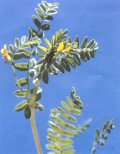
Yellow serradella

Yellow serradella
(High-resolution
image available)
NOTE: The information in this Agnote must be read in conjunction with Introduction to selecting and using pastures in NSW, which covers information on areas of adaptation, sources of variability, species mixtures, and important issues related to animal health and the conservation of native vegetation.
| Pasture type and use | Annual hard-seeded legume, with main growth in autumn, winter and spring. Mainly used as a pasture plant, and suited for grazing, hay or silage. Particularly tolerant of acid soils, and a deeper rooting system than that of sub clovers makes it more productive on deeper light soils. |
|---|---|
| Area of adaptation | North and Central Western Plains, North West Slopes, Central West Slopes, South West Slopes, Northern Tablelands, Central Tablelands, Southern Tablelands, and in well-drained light soil in coastal districts. |
| Min. average annual rainfall | 400 mm (northern NSW) to 350 mm (southern NSW). Also suited (given suitable soils) to medium and high rainfall areas. |
| Advantages |
|
| Disadvantages |
|
| Soil requirements | Best on deep (> 60–80 cm) well-drained lighter to medium loam soils. Can tolerate aluminium up to 35% of CEC (cation exchange capacity) — some variety differences. Will also grow on soil with pH up to 7.0, but beyond that, not known. Soils that set hard (e.g. sodic) don’t particularly suit serradella. For adequate growth, soil fertility deficiencies such as phosphorus, sulfur and molybdenum need correction. |
| Varieties | Select on the basis of maturity, hard-seed levels and tolerance to soil aluminium.
* Denotes that this variety is protected by Plant Breeder’s Rights. |
| Sowing rates: | Often sow serradella with other legumes (e.g. sub clover), because of soil type variability over a paddock. Generally sow two or more varieties to cater for variable seasons and conditions. Seed is of variable quality. High quality dehulled seed, sow at 1–3 kg/ha. Partially dehulled seed (enhanced), sow at 2–6 kg/ha. |
| Sowing time | Autumn, late March through to early June. |
| Companion species | Other winter legumes on variable soil paddocks, and a summer-growing perennial species (e.g. consol lovegrass). |
| Inoculation | Group G. Lime pelleting is desirable. |
| Major nutrient deficiencies | Phosphorus, sulfur, molybdenum, and occasionally potassium. |
| Main insect pests | Blue oat mite (some tolerance), redlegged earth mite (some tolerance), lucerne flea, vegetable weevil, jassids, Heliothis punctigera (native bud worm). |
| Main diseases | Very few disease problems yet observed. Potential diseases include brown leaf spot (Pleiochaeta setosa), grey mould (Botrytis cinerea), anthracnose, and cercospora fungus. |
| Management | Suited to moderate set stocking, as well as various rotational grazing practices. However, is often severely damaged if heavily grazed following a long period of regrowth resulting in rank growth. It is important to graze down dry summer material by early autumn to around 1–1.5 t/ha dry matter to encourage good autumn germinations. |
| Livestock disorders of particular note | No problems reported. |
| Additional tips |
|
| Further information |
|
Acknowledgments
Advice on livestock health disorders was provided by Dr Chris Bourke, Principal Research Scientist, NSW Agriculture, Orange. His contribution is gratefully acknowledged.
Photo: Warren McDonald, Former Technical Specialist (Pastures), NSW Agriculture, Tamworth.

